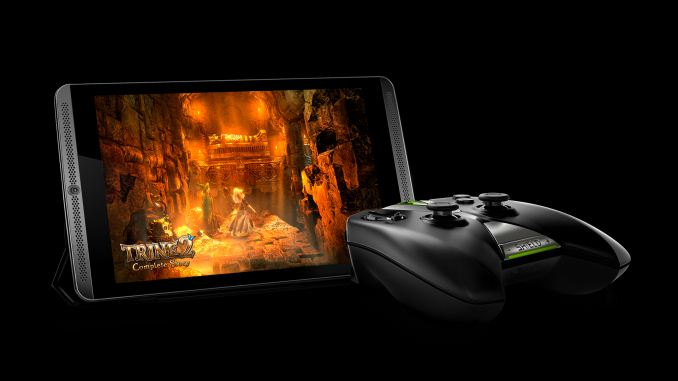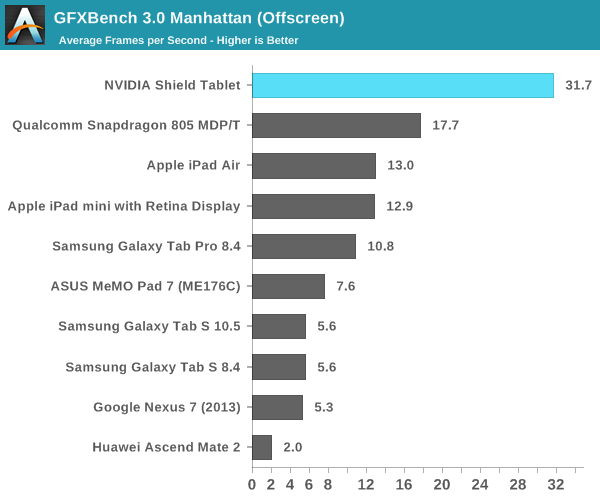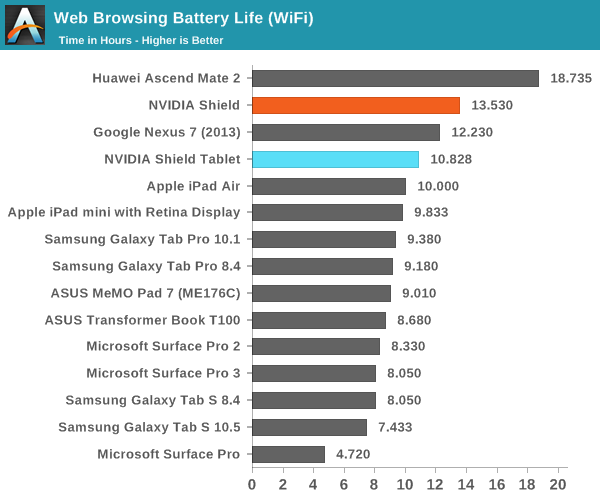Short Bytes: NVIDIA's SHIELD Tablet
by Jarred Walton on July 29, 2014 1:38 PM EST
Today's launch of the new SHIELD Tablet with NVIDIA's Tegra K1 SoC has muddied up the tablet waters a bit. We've posted our full coverage of the device, but for those looking for a short summary of the SHIELD Tablet – and whether it's worth buying or not – here's the synopsis of NVIDIA's latest entry into the mobile gaming market.
At its core, the SHIELD Tablet is a fully functional 8" Android tablet, which is quite a change from the initial SHIELD handheld gaming device. Of course it comes with NVIDIA's latest Tegra K1 processor, a quad-core ARM Cortex A15r3 CPU with a 192 CUDA core Kepler-derived GPU and 2GB DDR3L-1866. Storage options are currently 16GB or 32GB, and a microSD slot for additional storage. The display is a 1920x1200 IPS panel, and though it has a somewhat limited color gamut it's a decent if not exceptional display overall. Connectivity consists of 2x2 stream 802.11n WiFi and Bluetooth 4.0, with optional LTE support also available. The 16GB model comes with WiFi only while the 32GB model is equipped with LTE. A capacitive DirectStylus 2 also comes standard on both models.
The overall build quality and design are definitely improved over the Tegra Note 7, with a premium feel that was previously lacking. In many ways, it feels like a larger variant of the Nexus 5, and as an owner of a Nexus 5 that's pretty high praise. NVIDIA has also provided stereo front-facing speakers that sound better than those in most tablets. The only problem is that the SHIELD Tablet is rather heavy compared to the competition – it weighs 390g, compared to 294g for the Samsung Galaxy Tab S 8.4, but you get better performance with the added weight.



While there's certainly plenty of hyperbole involved with NVIDIA referring to the K1 as having supercomputing roots, from a pure performance perspective the K1 GPU delivers the goods, topping the charts in most of our graphics benchmarks. The CPU side of the equation isn't quite as impressive; it's faster than the previous generation Tegra 4, but given differences in platform, OS, etc. it can be difficult to draw firm conclusions. In general, you can expect somewhere around 5-25% better CPU performance than the Tegra 4, and the K1 tops most of the CPU charts and is at worst competitive with other leading SoCs. About the only potential weaknesses are in the NAND performance (random write is a bit low), and battery life takes a step back from the earlier SHIELD (though that's with a smaller battery) – and under heavy gaming workloads it can be less than three hours depending on the game. That's sort of the price you pay if you want maximum gaming performance from a tablet, though: battery life is going to take a hit when running full tilt.
NVIDIA has put quite a bit of effort into the software side of things as well. Besides all the usual Android tablet features – which basically work as expected – you get ShadowPlay support (record and/or stream your gaming sessions), GameStream (either local or remote is in beta), and access to GRID gaming as well. We've covered all of these previously, and there's nothing really new to add: they all work and offer features that you can't find on other tablets. If you're in the market for a tablet that can function as a portable gaming system, your options are quite limited.
The base price for the SHIELD Tablet is actually quite good, all things considered: $299 will get you one of the fastest Android tablets around, but don't forget the accessories. There's the DirectStylus 2, SHIELD wireless controller, and SHIELD Tablet cover. While you get a DirectStylus 2 with every SHIELD Tablet (a replacement stylus will set you back $20), the wireless controller is a $60 accessory and the magnetic cover is another $40 accessory. The cover isn't strictly necessary, but as someone that has used quite a few tablets without covers, over time getting some sort of cover is highly recommended, and the SHIELD Cover is a high quality cover that meshes well with the tablet. The wireless controller is a different matter: if you're looking at this as a gaming device, it's basically a required accessory. There are many Android games that are designed for a touchscreen, but if you want to use GameStream or play any of the games optimized for a gaming controller, you'll need the SHIELD wireless controller.
Taken as a complete package, then, you're looking at $400 for the 16GB WiFi model with accessories and $500 for the 32GB LTE model. You can argue that's too much, and I wouldn't necessarily disagree, but if you like the idea of a portable gaming tablet you don't really have many other choices. You can get the older NVIDIA SHIELD for $200, but that's half the price for basically half the performance and it was never really that useful except as a gaming device. The SHIELD Tablet on the other hand can function perfectly well as a tablet, and you only need to bring out the controller for times when you want to play games.
Ultimately, the SHIELD Tablet is a far more versatile solution than the original SHIELD, and if you're in the market for a new tablet it's still worth considering even if you don't care much about the gaming aspects – you can always add the controller at a later date. It might be a bit heavy compared to other options, but the performance and features definitely help set it apart. Unless you're particularly committed to a specific vendor for your devices, the SHIELD makes for a good addition to the Android family.
















32 Comments
View All Comments
mrdude - Tuesday, July 29, 2014 - link
Great? No. That's reaching par with the competition.What's still not 'great' is that 32GB requires purchase of LTE and means a hefty premium. Furthermore, it's still too chunky for a modern tablet (gotta cool that Tegra K1 somehow). And the stylus, while nice, is wasted on an 8" display. There's still no .ac WiFi either.
Don't get me wrong. It's a very nice device, but it fills the role of 'gaming tablet' better than it does a regular tablet. For those not focused on a gaming device, a Nexus 7 is still a better buy.
ArthurG - Tuesday, July 29, 2014 - link
Reaching par with the competition ? LOL and when I need max performance where's competition ? Stop to see only things from one side...and BTW SHIELD tablet with nvidia own version of app2SD can run software from microSD cards. it's even compatible with 128GB models ! Sandisk 32GB class 10 is less than $10...
Morawka - Tuesday, July 29, 2014 - link
lol at you complaining about a $100 incease to go from 16GB to 32GB with LTE.Here's what ipad mini retina does:
$399 for 16GB ipad mini retina
i want to upgrade to 32GB with LTE
ok so that's
$100 for Nand upgrade, and another $130 for LTE
Total price for 32GB LTE iPad Mini Retina = $629.00
TLDR: Apple charges $230 for 32GB LTE, Nvidia charges $100 and LTE is a bonus
mrdude - Wednesday, July 30, 2014 - link
You can compare practically anything to Apple electronics and mark it as a 'good deal.' The only point you're making is the obvious one that nobody disagrees with -- Apple's stuff is overpriced.The comment regarding 32GB was about the lack of a 32GB option w/o LTE. I tend to avoid external storage for any and every device I have (with good reason), and in 2014 a 'gaming tablet' -- or any other tablet/smartphone for that matter -- should come with 32GB standard. NAND is cheap, but companies looking to pad profit margins isn't.
makerofthegames - Tuesday, July 29, 2014 - link
How good has Nvidia been with regard to software updates? I checked on the older Shield, it seems to get updates about once a month, but is still on an old 4.4.2 as far as I can tell. Maybe I'm just looking in the wrong spots. I'm considering grabbing one of these, but only if it will still be supported for a few years.mutil0r - Tuesday, July 29, 2014 - link
4.4.3 was just a bug fix for Nexus devices. They've been pretty good at keeping the original Shield and the earlier note 7 tablet (i have one) updated. I've usually seen an OTA update every other month on my note 7 since I purchased it.ArthurG - Tuesday, July 29, 2014 - link
Nvidia support on SHIELD has been great. First device out of Nexus to receive Kitkat, lot of upgrades that bring not only bug fixes but also new features. It's the golden standard on Android and they already stated that it will receive L quickly.jjj - Tuesday, July 29, 2014 - link
Nvidia has a lot of software engineers and with no carriers delaying updates it's not bad. With some luck they might even have early access to Android L if any new Nexus is using Tegra so there is a chance they could deliver that update way fast.kron123456789 - Wednesday, July 30, 2014 - link
"an old 4.4.2"? Seriously? Can you tell what is new in 4.4.3 and 4.4.4 that makes 4.4.2 look old?Krysto - Wednesday, July 30, 2014 - link
It pisses me off that Nvidia isn't more serious about the smartphone market. This started when they FAILED in the smartphone market, because they mistakenly designed their chips to consume too much power, in order to beat others on performance (but because of delays they most failed on that, too), and now they've kind of just decided to go along with making "more" powerful chips, that can mainly be put just in tablets.It's very annoying. They should focus again on smartphones FIRST, and then just overclock or whatever, for their tablet version. It's harder to do it the other way around, when they focus on performance, and build more power-hungry architectures for that, that aren't as suited for phones.